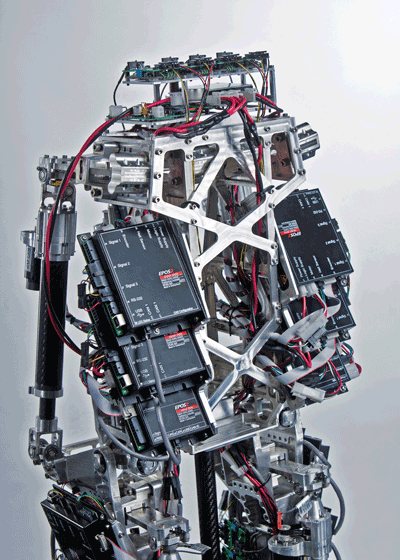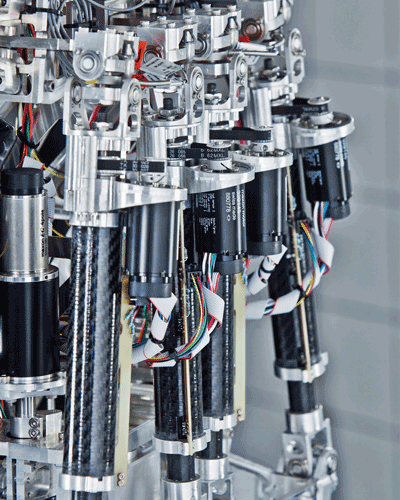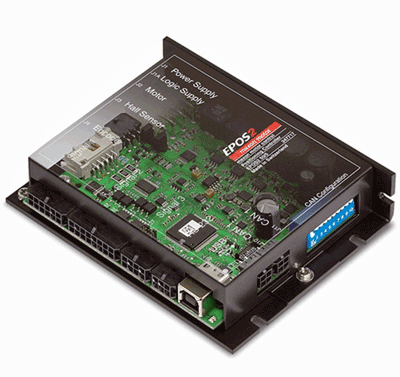Virginia Tech’s RoMeLa laboratory is designing the Shipboard Autonomous Fire Fighting Robot
BY DEBORA SETTERS
National Marketing Manager
maxon precision motors
www.maxonmotorusa.com
Agility, speed, strength, and balance are all qualities needed to fight fires, especially when those fires are shipboard. Such feats are difficult for humans, let alone humanoid robots. But that’s just what the RoMeLa labs team at Virginia Tech is working on.
Called SAFFiR, the autonomous robot will be able to carry and operate fire extinguishers, fire hoses, throw PEAT (Propelled Extinguishing Agent Technology) canisters, as well as interact with humans and find fires. The RoMeLa team, headed by Derek Lahr, Ph.D. candidate and project manager, has built the legs of the robot and is working on the rest of it.

Fig. 1: SAFFiR, the autonomous fire-fighting robot.
As shown in Fig 1 , the legs are a highly compact amalgamation of motors, pulleys, wire harnesses, and controllers. The system not only allows the robot to walk, but to do so while on a ship in the ocean as it pitches and rolls through the waves. Key concerns while designing the SAFFiR included the need to control the robot’s locomotion from both a purely mechanical stance as well as from a balance standpoint. For example, if the ship pitches forward, the robot might need to speed its leg movement, but also produce a longer stride length to catch itself from getting off balance.
For six degrees of freedom in each leg, the robot is equipped with six motors that need to be controlled and to be integrated with the rest of the robot electronics. All 12 motors used for the legs must interact. At different parts of a stride, each leg will alternately move fast and free, then slow and more controlled, requiring both speed and torque management. Besides being compact enough to fit into the leg design, the motors also needed to be lightweight, since they are the largest amount of mass in the robot. Research was necessary to find components with the highest power-to-weight ratio for brushless dc motors.
At this point in the design testing phase, the robot is tethered much of the time, but testing has confirmed the use of two 10-Ah lithium polymer batteries (about the size of a small brick) can be used to power the robot for at least a half hour with a 20-A average current draw. This includes, of course, all the motors, sensors, and controls.

Fig. 2: The design team at Virginia Tech stacked their EPOS controls to save space and keep wire harnesses as short as possible.
Because the robot operates from a closed-loop system, and uses 12 motors just in the legs (there will be another 12 in the arms and hands, as well as two in the neck), the controllers had to be able to handle the high data load. The team chose motor controllers with a CANopen interface because they were familiar with the network protocols and were sure it could handle the on-the-fly switching required for the project. The controllers chosen use advanced 32-bit DSPs, which provided the team extended functionality. Two different controllers were used, the larger ones only take up 120 x 93.5 x 27 mm, while the smaller ones are 105 x 83 x 24 mm. Fifty-volt units were used for the joints, and 24-volt units were used everywhere else.
The controls were also used in two different modes: position-control mode and force-control mode. Position-control mode allows for high-level controllers to read position data from the sensors and closely regulate the specific position of the leg so that corrections can be incorporated while walking. Force-control mode is the latest thing in locomotion; it combines current-control circuitry with load-cell feedback to create a “pure force” actuator, which allows the leg to swing freely.
The devices easily switch from position control to force control at the last millisecond so that stride length and impact power can be accurately controlled and the actuators are not compromised. Because the controllers are network expandable to 127 nodes, and come with an easy-to-use GUI-based free software package for easy programming, the team was able to interface all the functions they needed and problem-check the software prior to actual implementation.

Fig. 3: This closeup shows four 30-mm brushless motors manufactured by maxon precision mPrecision Motors.
So far, the project uses multiple 30-mm motors from maxon precision motors for the legs. Wherever possible, 100-W motors are incorporated to keep the weight of the unit at a minimum. For critical joints like those in the knees, 200-W motors are used. The knees of the robot, just like human knees, take the brunt of the load, especially when squatting or kneeling. These joints also have to move the fastest while walking and need the additional torque and speed combination available with the larger wattage units. The motors also feature a noncogging system, high efficiency, and the quiet operation of a brushless motor.

Fig. 4: The EPOS2 controller offers a production-friendly modular system for multi-axis distributed control.
The controllers chosen for the project were maxon’s EPOS series controllers, which came equipped with a CANopen bus system interface. The EPOS embedded controllers well suited for multiaxis distributed control that also feature electronic gearing, PVT, step and direction, and point-to-point positioning. The units were developed to meet demanding size and performance requirements often found in robotic, medical, and semiconductor applications.
Overall, the SAFFiR project is progressing well, the use of the lightest-weight motors with the highest speed to torque ratios, the lightweight EPOS control units, and the unique ability to shift from position to force control on the fly are all making the design and test process run smoothly. Since the legs are the most complicated and difficult section to design, the team at Virginia Tech expects few complications going forward.
Virginia Tech’s RoMeLa laboratory is designing the Shipboard Autonomous Fire Fighting Robot, SAFFiR, with funding from the U.S. Naval Research Laboratory. ■
Advertisement
Learn more about Maxon Precision Motors





